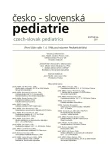Necrotizing enterocolitis in full-term neonates. Case report and review of the literature
Authors:
K. Maťašová 1; D. Murgaš 2; M. Zibolen 1
Authors‘ workplace:
Neonatologická klinika JLF UK a UNM, Martin
prednosta prof. MUDr. M. Zibolen, CSc.
1; Klinika detskej chirurgie JLF UK a UNM, Martin
prednosta doc. MUDr. M. Dragula, PhD, mim. prof.
2
Published in:
Čes-slov Pediat 2011; 66 (6): 372-379.
Category:
Case Report
Overview
Necrotizing enterocolitis (NEC) may rarely develop in full-term newborns. NEC in term infants is characterised by the early onset at the age of 2–4 days, the colon is the typical location of inflammation and necrosis. The third difference as compared to preterm babies is the association with previous underlying illness that alters intestinal blood flow. Aetiology of NEC remains poorly understood but the presence of other risk factor, colonisation of the gut with pathogenic microorganisms and enteral feeding seem to be of great importance. Sonographic examination may be helpful for the early diagnosis of patients with NEC as the gas (granular echogenicities) in the bowel wall can be seen in early stage of NEC.
In this report we present a case of a boy born at 36 gestational weeks, his birth weight was 1950 g, Apgar score 10, 10 in the first and fifth minutes, respectively. On the second day antibiotics were indicated due to perinatal infection (colonisation with Escherichia coli, low leukocyte count, low platelet count) with negative blood culture, the baby was hemodynamically stable. At the age of 4 days bloody vomiting appeared, abdominal radiography showed pneumatosis intestinalis – the typical finding for NEC. Despite the treatment 24 hours later pneumoperitoneum appeared, surgical intervention was contraindicated due to untreatable coagulopathy. The baby died at the age of 6 days. At autopsy the presence of extensive NEC with bowel perforation and diffuse peritonitis were confirmed.
Key words:
necrotizing enterocolitis, full-term neonate, pneumoperitoneum, pneumatosis intestinalis
Sources
1. Ng S. Necrotizing enterocolitis in the full-term neonate. J Pediatr Child Health 2001; 37 : 1–4.
2. Neu J. Neonatal necrotizing enterocolitis: an update. Acta Paediatr 2005; 94(Suppl): 100–105.
3. Lambert DK, Christensen RD, Henry E, et al. Necrotizing enterocolitis in term neonates: data from a multihospital health-care system. J. Perinatol 2007; 27 : 437–443.
4. McElhinney DB, Hedrick HL, Bush DM, et al. Necrotizing enterocolitis in neonates with congenital heart disease: risk factors and outcomes. Pediatrics 2000; 106 : 1080–1087.
5. Maayan-Metzger A, Itzchak A, Mazkereth R, et al. Necrotizing enterocolitis in full-term infants: case-control study and review of the literature. J Perinatol 2004; 24 : 494–499.
6. Bolisetty S, Lui K, Oei J, et al. A regional study of underlying congenital diseases in term neonates with necrotizing enterocolitis. Acta Paediatr 2000; 89 : 1226–1230.
7. Lee JS, Polin RA. Treatment and prevention of necrotizing enterocolitis. Sem Neonatol 2003; 8 : 449–459.
8. Stout G, Lambert DK, Baer VL, et al. Necrotizing enterocolitis during the first week of life: a multicentered case-control and cohort comoarison study. J Perinatol 2008; 28 : 556–560.
9. Christensen RD, Lambert DK, Schmutz N, et al. Fatal bowel necrosis in two polycytemic term neonates. Fetal Pediatr Pathol 2008; 27 : 41–44.
10. Fedorová M, Zlatohlávková B, Kytnarová J, Malošková G, Kršek M, Plavka R. Intrauterinní růstová retardace a její vliv na další vývoj extrémně nezralých novorozenců. Čes-slov Pediat 2009; 64 : 359–364.
11. Figueras-Aloy J, Rodríguez-Miguélez JM, Iriondo-Sanz M, et al. Intravenous immunoglobulin and necrotizing enterocolitis in newborns with hemolytic disease. Pediatrics 2010; 125 : 139–144.
12. Guner YS, Malhotra A, Ford HR, et al. Association of Escherichia coli O157:H7 with necrotizing enterocolitis in a full-term infant. Pediatr Surg Int 2009; 25 : 459–463.
13. Raboei EH. Necrotizing enterocolitis in full-term neonates: is it aganglionosis? Eur J Pediatr Surg 2009; 19 : 101–104.
14. Minkoff H, Chervenak FA. Elective primary ceaserean delivery. N Engl J Med 2003; 348 : 946–950.
15. Amer T, David R, Oberfield SE. Necrotizing enterocolitis and hypothyroidism in a newborn infant: treatment with intravenous L-thyroxin. Am J Perinatol 1994; 11 : 30–32.
16. Nowicki PT. Ischemia and necrotizing enterocolitis: where, when and how. Sem Pediatr Surg 2005; 14 : 152–158.
17. Bell MJ, Shackelford P, Feigin RD, et al. Epidemiologic and bacteriologic evaluation of neonatal necrotizing enterocolitis. J Pediat Surg 1997; 14 : 1–4.
18. Walsh MC, Kliegman RM. Necrotizing enterocolitis: treatment based on staging criteria. Pediatr Clin North Am 1986; 33 : 179–202.
19. Kessler U, Mungnirandr A, Nelle M, et al. A simple presurgical necrotizing enterocolitis-mortality scoring system. J Perinatol 2006; 26 : 764–768.
20. Pourcyrous M, Korones SB, Yang W, et al. C-reactive protein in the diagnosis, management, and prognosis of neonatal necrotizing enterocolitis. Pediatrics 2005; 116 : 1064–1069.
21. Silva CT, Daneman A, Navarro OM, et al. Correlation of sonographic findings and outcome in necrotizing enterocolitis. Pediatr Radiol 2007; 37 : 274–282.
22. Dilli D, Suna Oğuz S, Erol R, et al. Does abdominal sonography provide additional information over abdominal plain radiography for diagnosis of necrotizing enterocolitis in neonates? Pediat Surg Int 2010; 1–7. Article in press.
23. Kim WY, Kim WS, Kim IO, et al. Sonographic evaluation of neonates with early-stage necrotizing enterocolitis. Pediatr Radiol 2005 : 1056–1061.
24. Mohan P, Abrams SA. Oral lactoferrin for the treatment of sepsis and necrotizing enterocolitis in neonates. Cochrane Database Syst. Rev. 2009;21:CD007138.
25. Ostlie DJ, Spilde TL, St Peter SD, et al. Necrotizing enterocolitis in full-term infants. J Pediatr Surg 2003; 38 : 1039–1042.
Labels
Neonatology Paediatrics General practitioner for children and adolescentsArticle was published in
Czech-Slovak Pediatrics

2011 Issue 6
Most read in this issue
- Necrotizing enterocolitis in full-term neonates. Case report and review of the literature
- Off-label prescribing in pediatrics
- Changes in electrical conductivity of the skin due to painful stimuli in newborns of different gestational categories and comparison with changes in selected physiological parameters
- The development of neonatal care and evaluation of the first five years experience in surgery of cleft lip in the neonatal period
